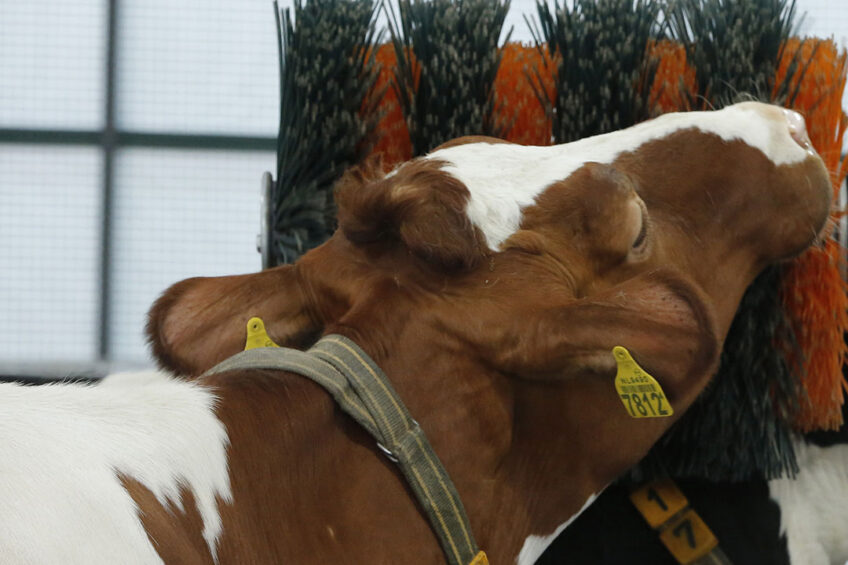Brush benefits: More than a grooming aid for dairy cows

It is more than likely that you will encounter some strategically placed cow brushes on any given dairy farm as an enrichment tool and grooming aid but there are other benefits too.
As humble as brush grooming seems when it comes to dairy cows, it is not just for enrichment or grooming behaviour purposes. When it comes to these handy on-farm tools, they not only keep cows happy but also support the farmer by helping keep the bottom line healthy.
From swinging and rotating brushes to ones that can treat skin disorders, they increase animal well-being, positively impact performance, milk yield, reduce stress, improve blood circulation, udder health and play a role in mastitis reduction. Investing in these to remove dirt and debris can bring the herd an overall sense of well-being, thereby playing a part in healthy animals as well as a healthy farm business.

According to Erik Pel, commercial director at Comfy, a company that specialises in cow brushes, the best spots for brushes to be placed depends on the barn layout. “Mostly you see them placed in crossovers and also junctions in the barn, at the back of the barn and near the area where the cubicles are located. Pel advises not to place them too near the water drinking section where the access to water could be obstructed.

Longevity
With all the benefits that the animals reap, the life-time of the average dairy farm brush is generally quite long. Pel adds that the brush cylinders may need changing, however, “the brushes can last for a long time, about 8 – 10 years. A good indication is when the brush hairs are bent, then it’s time to replace them.” Pel adds that Comfy chose to use Nylon bristles for these main reasons – for longevity and durability as well as for keeping brush shape for longer, although polypropylene bristles are also used in some models on the market.
Whether a farmer chooses a rotating, swinging or stationery brush is really up to what the farmer thinks is needed on-farm – from low voltage mechanical options and the simplest stationery ones to brushes with the possibility of adding insecticides to treat skin disorders such as scabies, lice and flies. There is an array on offer on the market to suit all farm needs. Pel tells us that Comfy also offers a ‘Basic’ range which is targeted at groups of fewer animals of about 10 cows, and this range can can also be used outside when cows are out in pasture or be placed around the barn area.

Various options
• Rotating brushes:This brush rotates on a horizontal arm attached to a motor, moving left and right, they reach large area over the cow’s back.
• Swinging brushes:This brush can swing backwards, side to side with increased motion options.
• Stationary:These can easily be made and it isn’t uncommon for farmers to create one themselves. The reach of these ones are not as wide compared to the mechanical options. Commercial stationary brushes are also available.

Positive impacts
• Increase of exercise/ walking
• Less time that the udder is exposed to bacteria when lying down
• Is a stress reliever which makes animals more productive
• Increases blood circulation to udder
Factors farmers should consider
• Rotating, Swinging or Stationery – do I need maximised brushing efficiency?
• Is it easy to mount and install?
• Built-in resistance?
• If upgrading, does it use less energy than a currently installed model?
• Is it suitable for cows in heat?
• Will it be used in barn or outside for cows in pasture?
When investing in brushes, it’s important to consider other various factors like budget, amount of animals per brush. Pel adds that having about 60 cows per brush is sufficient and a good indication of how many should be used on farm and around the barn area.
Calf brushes are also available with softer bristles (for 2 – 6 months old), mechanical brushes for calves are a good option for natural grooming behaviour. Pel adds, “Rotating calf brushes weigh less compared to cow brushes, this means that the calf will have a softer impact on the back compared to a normal, heavier cow brush.”
Whichever option is chosen, using a brush assists in making sure that barn equipment and facilities are protected, animals pose no harm to themselves by using other barn equipment that are not suitable for grooming and in addition enriches quality of life of cows on-farm.
Research with isolated cows
Research was recently carried out by to examine whether enriching the environment of the isolation pen using both tactile (i.e. an automated grooming brush) and visual (i.e. a mirror) stimulation could alleviate stress induced in socially isolated dairy cows.
Research results found that there was no indication of immediate stress reduction through brush/mirror usage. The presence of an automated grooming brush, a mirror or both an automated grooming brush and mirror in the isolation pen was not associated with reduced indicators of stress when compared to the non-enriched environment. There was further indication in the study that there is a need to further explore practices to reduce stress during social isolation.
However, with cows kept in a dry pen, Pel comments, “Our experience is that cows which are held in a dry-pen without access to a brush will make its way to the cow brush first, when they are getting back to the herd. We see this often and this shows the added value of having a brush. The animal will tell it to you!”
For more info on Comfy brush solutions: www.comfy-solutions.com
Join 13,000+ subscribers
Subscribe to our newsletter to stay updated about all the need-to-know content in the dairy sector, two times a week.










